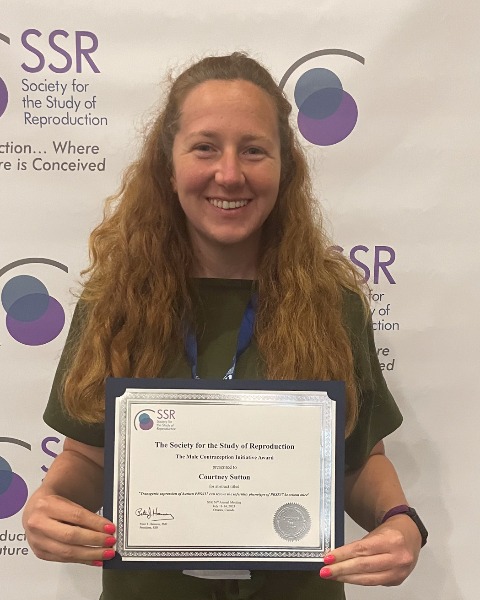Testis/Sperm
Poster Session A
(P-495) Exploring the fertility rescue effect of transgenic expression of human PRSS55 in Prss55 null mice
Wednesday, July 17, 2024
8:00 AM - 9:45 AM IST
Room: The Forum

Courtney Sutton, PhD
Postdoctoral Research Fellow
Baylor College of Medicine, United States
Poster Presenter(s)
Abstract Authors: Courtney M. Sutton1,2, Alexis R. Souto1,2, Thomas X. Garcia1,2,3, and Martin M. Matzuk1,2,*
1Center for Drug Discovery, Baylor College of Medicine, Houston, TX; 2Department of Pathology & Immunology, Baylor College of Medicine, Houston, TX; 3Scott Department of Urology, Baylor College of Medicine, Houston, TX
Abstract Text: The need for a non-hormonal male contraceptive pill for men still exists. Serine protease 55 (PRSS55) is a male reproductive tract-specific protein that when knocked out in mice leads to male infertility, making it a viable contraceptive target. The goals of our studies were to determine whether we could rescue fertility in Prss55 KO mice with human PRSS55, allowing for a more suitable animal model to test the efficacy of drug candidates. We used pronuclear injection to generate transgenic mice expressing tagged-human PRSS55 protein. We then crossed the transgenic mice with Prss55 KO mice to generate a rescue line. After generating our mouse lines, we then performed a fertility assessment, analyzed testes and epididymis grossly and histologically, and determined sperm parameters of each line. Morphological differences were observed between our rescue mouse lines and our WT mice when comparing body weight and testis weight, where humanized transgenic mice had lighter weights. Apart from hyperactivation, where rescue males had decreased hyperactivation, all other sperm parameters were similar between the two groups. Our humanized transgenic mouse lines’ poor ability to rescue fertility might be accounted for because of the low homology (57%) between human and mouse PRSS55. PRSS55 is required for male fertility and is a viable target as a small molecule for non-hormonal male contraceptive.
This study has been supported by Eunice Kennedy Shriver National Institute of Child Health and Human Development T32 HD098069 (trainee subaward to C.M.S.), the Schepps Foundation, Bill and Melinda Gates Foundation INV-001902 (to M.M.M., and T.X.G), National Institutes of Health (NIH) R01 HD088412 and P01 HD087157 (to M.M.M, and T.X.G.), NIH R01 HD106056 and R01 HD095341 (to T.X.G. and M.M.M), Male Contraceptive Initiative David Sokal Innovation Award 2021-302 (to T.X.G.)
1Center for Drug Discovery, Baylor College of Medicine, Houston, TX; 2Department of Pathology & Immunology, Baylor College of Medicine, Houston, TX; 3Scott Department of Urology, Baylor College of Medicine, Houston, TX
Abstract Text: The need for a non-hormonal male contraceptive pill for men still exists. Serine protease 55 (PRSS55) is a male reproductive tract-specific protein that when knocked out in mice leads to male infertility, making it a viable contraceptive target. The goals of our studies were to determine whether we could rescue fertility in Prss55 KO mice with human PRSS55, allowing for a more suitable animal model to test the efficacy of drug candidates. We used pronuclear injection to generate transgenic mice expressing tagged-human PRSS55 protein. We then crossed the transgenic mice with Prss55 KO mice to generate a rescue line. After generating our mouse lines, we then performed a fertility assessment, analyzed testes and epididymis grossly and histologically, and determined sperm parameters of each line. Morphological differences were observed between our rescue mouse lines and our WT mice when comparing body weight and testis weight, where humanized transgenic mice had lighter weights. Apart from hyperactivation, where rescue males had decreased hyperactivation, all other sperm parameters were similar between the two groups. Our humanized transgenic mouse lines’ poor ability to rescue fertility might be accounted for because of the low homology (57%) between human and mouse PRSS55. PRSS55 is required for male fertility and is a viable target as a small molecule for non-hormonal male contraceptive.
This study has been supported by Eunice Kennedy Shriver National Institute of Child Health and Human Development T32 HD098069 (trainee subaward to C.M.S.), the Schepps Foundation, Bill and Melinda Gates Foundation INV-001902 (to M.M.M., and T.X.G), National Institutes of Health (NIH) R01 HD088412 and P01 HD087157 (to M.M.M, and T.X.G.), NIH R01 HD106056 and R01 HD095341 (to T.X.G. and M.M.M), Male Contraceptive Initiative David Sokal Innovation Award 2021-302 (to T.X.G.)
